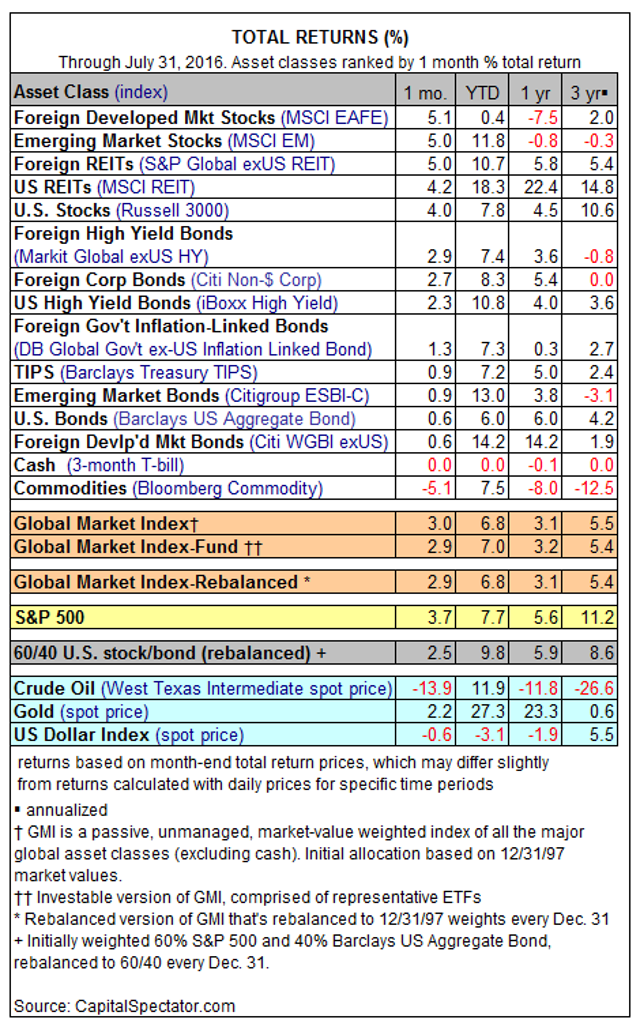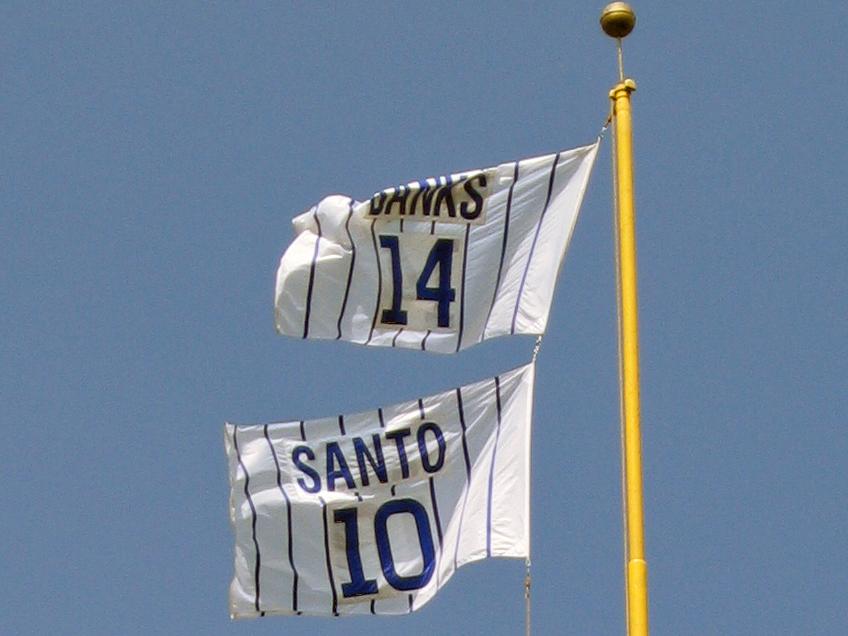Punch Bowl More than Half Full ?
Net flows into ETFs totaled $52.6B in July, according to FactSet, with just about every asset class seeing fresh money, particularly U.S. equities, which drew in $30.1B.
U.S. fixed-income saw a robust $11.6B of inflows - a possible source of concern for some analysts, noting high demand for both "risk-on" and "risk-off" assets. It wasn't just Treasurys though, as the data shows plenty of demand last month for investment-grade corporate paper, emerging-market bonds, and high-yield debt.
http://seekingalpha.com/news/3198724-etf-inflows-soar-julyGraphics from
@Ted's original article from MarketWatch


 http://seekingalpha.com/article/3994368-major-asset-classes-july-2016-performance-review
http://seekingalpha.com/article/3994368-major-asset-classes-july-2016-performance-reviewBEIJING (Reuters) - A raft of global risks that could adversely affect the United States remains on the horizon and requires close monitoring, Dallas Federal Reserve Bank President Robert Kaplan said on Tuesday.
Kaplan, along with several other Fed policymakers, has urged renewed caution in trying to lift rates again...
"I am closely monitoring how slowing growth, high levels of overcapacity and high levels of debt to GDP in major economies outside the U.S. might be impacting economic conditions in the U.S.," Kaplan said at an event in Beijing.
In his second appearance within a week, Kaplan, a centrist at the U.S. central bank, repeated that he continues to back tightening monetary policy in a gradual and patient manner.
Chief among his concerns is sluggish U.S. growth exacerbated by a changing world in which economies are more globally interconnected.
"It's going to take many
years and maybe decades for China to manage through overcapacity and high levels of debt to GDP," Kaplan added. "I think sudden jarring traumas ... may make that adjustment more challenging."
On Monday New York Fed President William Dudley, a permanent voter on the Fed's rate-setting committee, said that while it was "premature" to rule out a rate increase this year,
negative economic shocks were more likely than positive ones.https://www.yahoo.com/news/feds-kaplan-urges-patience-raising-rates-points-global-115047772--business.html?ref=gsA Brief Note From G M O's Ben Inkster in their 2nd Quater Newsletter
"So what can we do to protect portfolios ..."
"a deeper analysis of what led returns to be disappointing for
the asset classes that have lagged may help investors avoid the error of abandoning decent assets just when their time may be about to come."
This is the nature of the discount-rate-driven gains for asset classes such as equities, bonds, and real
estate. Beyond the discount rate change, it is still true that US equities have done surprisingly well,
emerging equities surprisingly badly, and so on. But even if those “surprises” are permanent (and
our guess is that for the most part they are not) the fact that the valuation of US equities has risen
guarantees that the future returns to US equities from here will be lower than they would have been
otherwise, and the same is true for all of the long-duration assets whose discount rates have fallen
over the period.
The most shocking hole that will be blown through people’s portfolios is if discount rates rise again
fairly quickly. Even if the circumstance is one in which the global economy is doing well, the impact
of a 1.5% increase in the discount rate on equities from here is a fall of over 30%, which would
almost certainly be enough to swamp the earnings impact of the decent growth. For bonds, of course,
there would be no possible counter to the discount rate effect. For a portfolio that is fully invested in
long-duration assets (i.e., consists of a combination of stocks, bonds, real estate, and private equity),
the possible performance implication is on the order of the falls experienced in the financial crisis –
perhaps a 20-33% fall depending on the weightings – despite the fact that the global economy was doing just fine.
So what can we do to protect portfolios against this possibility? One answer would be to hold cash, which, as a zero-duration asset, would be a beneficiary of rising discount rates. The trouble with cash, of course, is that if the discount rates do not rise, it is doomed to deliver little or nothing. What
we would ideally like is to hold a short-duration risk asset – one where if nothing changes we are getting paid a decent return but where a rising discount rate will not destroy multiple
years’ worth of
returns.
We believe alternatives fit the bill pretty well. If things hold together, we should expect to
make money from activities such as merger arbitrage or exploiting carry trades or global macro. If the
world does surprisingly well and causes investors to raise their expectations for discount rates, these
strategies should be largely unaffected and could still make money. If we head into a severe recession
or financial crisis, they will presumably lose money, as we saw in 2008, but that is no different from
other risk assets. To be clear, I’m not arguing that the returns to alternatives are likely to be a lot
higher than we have seen since 2009-10. Alternatives have been mildly disappointing since 2009, doing almost 1% worse than one might have expected. The more sobering truth is that the 4.2% return they have achieved since then simply looks pretty good given the other choices on offer, and
their lack of vulnerability to rising discount rates is a comfort in a world where almost everything in
a traditional portfolio is acutely vulnerable to discount rate rises should they happen.
Today does not look like a great opportunity to reach for risk, despite the temptation in the face of unprecedentedly unattractive yields on government debt.....
The charm of alternatives today is that we believe they should perform similarly in either the
temporary or permanent shift scenario, and there are almost no other assets with expected returns
above cash for which that is the case. The problem with alternatives is that they are more complicated
to manage than traditional assets, generally have higher fees associated with them, and require more
oversight. Normally, those problems are enough to make them less appealing than traditional risk
assets such as equities and credit. Today, however, they seem well worth the extra effort. Their
generally disappointing performance over recent
years, rather than a sign to dump them once and for
all, should probably be recognized as a signal of their potential utility in the market environment we face in the coming
years.
There is no panacea for the low returns implied by asset valuations today. Anyone suggesting
differently is either fooling themselves or trying to fool you. But piling into the assets that have been the biggest help to portfolios over the past several
years, as tempting as it may be, is probably an even worse idea than it usually is. And a deeper analysis of what led returns to be disappointing for
the asset classes that have lagged may help investors avoid the error of abandoning decent assets just when their time may be about to come.
https://www.gmo.com/docs/default-source/public-commentary/gmo-quarterly-letter.pdf?sfvrsn=30A Q R funds
http://quicktake.morningstar.com/fundfamily/aqr-funds/0C000021ZL/fund-list.aspxArbitrage funds
http://quicktake.morningstar.com/fundfamily/arbitrage-fund/0C00001YYL/snapshot.aspxLong-Short Equity: Total Returns
http://news.morningstar.com/fund-category-returns/long-short-equity/$FOCA$LO.aspxMultialternative: Total Returns
http://news.morningstar.com/fund-category-returns/multialternative/$FOCA$GY.aspx



